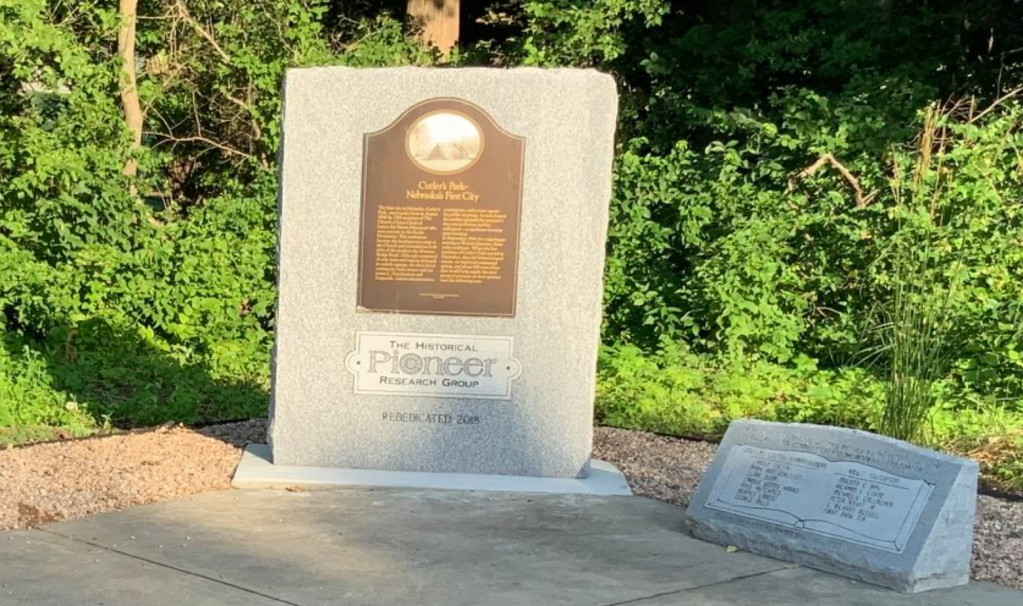The Methodists were renowned for their circuit riders, ministers who went from congregation to congregation throughout early North Omaha. As the neighborhoods north of Ames Avenue started opening to development in the 1880s, one rider came north to serve the area including Monmouth Park and Tuttle’s Addition. This is a history of the Ames Avenue United Methodist Church.

The Ames Avenue Methodist Episcopal Church started life as the Monmouth Park Methodist Episcopal Church at North 34th and Larimore Streets in 1889. Served by an Omaha circuit rider named by Rev. William B. Slaughter, the congregation was established in the spring of 1888. The first church was built a year later. The little wooden clapboard church served an influx of new residents from the surrounding neighborhoods, and after just a few years a new church was needed to seat all the members. Rev. F. W. Bross was the longtime minister at the church. Soon after they changed their name to Hirst Memorial Methodist Episcopal Church in honor of a benefactor for their building.
In May 1902, the church was completely obliterated by a tornado. Contemporary newspaper reports said, “…there is something in the misfortune growing out of even a miniature cyclone that commands popular sympathy.” Church members had mostly rebuilt their building by July 1902, and in 1905 dedicated the “larger, finer chapel” where “the membership has doubled in numbers and influence.”
In December 1927, the Florence Methodist Episcopal Church was merged with Hirst Memorial. Founded in 1854, that congregation brought 30 new members into Hirst.

Replacing their wooden structure, renaming the church, and moving a half-mile away, the Ames Avenue Methodist Episcopal Church opened up at 4023 Ames in 1929. For the next 40 years, the congregation held regular Sunday services, holiday events, bible studies, choir practices, and all the fellowship gatherings a Methodist congregation should.
However, starting in the early 1960s the surrounding neighborhoods were swept by white flight. This included the Central Park, Monmouth Park, Bedford Place, Collier Place, and Fairfax. Within the decade, only the oldest white residents were still living in the neighborhood.
In the meantime, the Methodists hired the first African American minister for the church, Rev. Solomon Phifer (1931-2017), in 1970. At that point there were 120 members, with only two Black families in the congregation. Most of the members were seniors who bought homes in the area in after World War II and didn’t want to move. As they died off and Ames Avenue Methodist Church failed to successfully attract enough new African American neighbors to become members, the church struggled severely.

After managing to stay open for a while, Ames Avenue UMC folded permanently in 1975. The building was sold soon after, first serving as the Trinity Hope Tabernacle from 1975 to 1978, then become the longtime home of Freestone Baptist Church, which continues to call the building home today. Freestone has been in the building longer than Ames Avenue Methodist was now.
The City of Omaha Landmark Heritage Preservation Commission has identified it as a potential to recognize, but the building has not been acknowledged for its historical cultural relevance to the surrounding neighborhood with a listing on the National Register of Historic Places or a designation as an official Omaha Landmark.
You Might Like…
MY ARTICLES RELATED TO THE HISTORY OF AMES AVENUE
NEIGHBORHOODS: Saratoga | Collier Place | Monmouth Park
INTERSECTIONS: 30th and Ames | 40th and Ames | 24th Street | North Freeway | Fontenelle Boulevard
BUSINESSES: LaRue’s | Max I. Walker | North Star Theater aka Ames Theater | King Solomon’s Mines aka Shaver’s | Beacon Theater | Parkside Cafe | Ames Plaza | Battiato’s Super Market | Mergen House
PUBLIC PLACES: Ames Avenue Bridge | Saratoga School | Charles Washington Branch Library | Monmouth Park School | North High School | Fontenelle Park
OTHER: Druid Hall | St. Vincent’s Retirement Home | Ames Avenue United Methodist Church | Mergen House
MY ARTICLES ABOUT HISTORIC CHURCHES IN NORTH OMAHA
GENERAL: Directory | Black Churches | Florence Churches
METHODIST: 17th Street | Pearl Memorial UMC | St. John’s AME | Bethel AME | Cleaves Temple | Ames Avenue | Trinity | Walnut Hill | 18th Street |
BAPTIST: Mount Moriah | Zion | Immanuel |
CATHOLIC: Holy Family | St. Benedict the Moor | St. John’s | Holy Angels | Sacred Heart | St. Cecilia | St. Therese
PRESBYTERIAN: Calvin Memorial | Hillside | First United | Covenant | St. Paul
EPISCOPALIAN: St. Phillips |
COGIC: New Bethel | Faith
LUTHERAN: Hope | St. Paul | Mount Olive
OTHERS: Mt. Calvary |
RELATED: St. Clare’s Monastery | Omaha Presbyterian Theological Seminary | North Omaha Catholic Schools | Black Churches | Florence Churches | Kountze Place Churches






Leave a comment